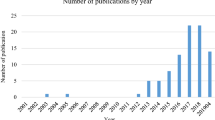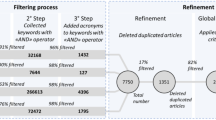Abstract
The Reconfigurable Manufacturing Systems (RMS) is the next step in manufacturing, allowing the production of any quantity of highly customised and complex parts together with the benefits of mass production. In RMSs, parts are grouped into families, each of which requires a specific system configuration. Initially system is configured to produce the first family of parts. Once it is finished, the system is reconfigured in order to produce the second family, and so forth. The effectiveness of a RMS depends on the formation of the optimum set of part families addressing various reconfigurability issues. For this, a two-phase approach is developed where parts are first grouped into families and then families are sequenced, computing the required machines and modules configuration for each family. In the First phase, parts are grouped into families based on their common features. The correlation matrix is developed as operations sequence similarity coefficient matrix. Principal Component Analysis (PCA) is applied to find the eigenvalues and eigenvectors on the correlation similarity matrix. A scatter plot analysis as a cluster analysis is applied to make parts groups while maximizing correlation between parts as per operations sequence similarity. Agglomerative Hierarchical K-means algorithm improved the parts family formation using Euclidean distance resulting a set of part families. In the second phase, optimal selection and sequences of the resulted part families is achieved by using a Mixed Integer Linear Programming (MILP) model minimizing reconfigurability and under-utilization costs to get the minimum cost solution.




Similar content being viewed by others
References
Koren, Y., Jovane, F., Heisel, U., Moriwaki, T., Pritschow, G., Ulsoy, A.G., VanBrussel, H.: Reconfigurable Manufacturing Systems. CIRP Ann. 48(2), 527–540 (1999)
Xiaobo, Z., Jiancai, W., Zhenbi, L.: A stochastic model of a reconfigurable manufacturing system Part 1: a framework. Int. J. Prod. Res. 38(10), 2273–2285 (2000)
Lokesh,.K., Jain, P.K.: A model and optimization approach for reconfigurable manufacturing system configuration design. Int. J. Prod. Res. 50(12), (2011).
Abdi, M.R., Labib, A.W.: Grouping and selecting products: the design key of Reconfigurable Manufacturing Systems (RMSs). Int. J. Prod. Res. 42(3), 521–546 (2004)
Galan, R., Racero, J., Eguia, I., Garcia, J.M.: A systematic approach for product families formation in Reconfigurable Manufacturing Systems. Robot. Comput. Integr. Manuf. 23, 489–502 (2007)
Vakharia, A., Wemmerlov, U.: A comparative investigation of hierarchical clustering techniques and dissimilarity measures applied to the cell formation problem. J. Oper. Manag. 13, 117–138 (1995)
Yin, Y., Yasuda, K.: Similarity coefficient methods applied to cell fprmation problem: a taxonomy and review. Int. J. Prod. Econ. 101, 329–352 (2006)
Papaioannou, G., Wilson, J.M.: The evolution of cell formation problem methodologies based on recent studies (1997–2008): review and directions for future research. Eur. J. Oper. Res. 206, 509–521 (2010)
Jolliffe, I.T.: Principal Component Analysis. Springer, New York (1986)
Preisendorfer, R.: Principal Component Analysis in Meteorology and Oceanography. Elsevier Science (1988).
Pearson, K.: On lines and planes of closest fit to systems of points in space. Philos. Mag. 2, 559–572 (1901)
Tuncer, Y., Tanik, M.M., Alison, D.B.: An overview of statistical decomposition techniques applied to complex systems. Comput. Stat. Data. Anal. 52(5), 2292–2310 (2008)
Horenko, I., Dittmer, E., Schütte, C.: Reduced Stochastic Models for Complex Molecular Systems. Comput. Vis. Sci. 9(2), 89–102 (2006)
Rothenberger, M.A., Dooley, K.J., Kulkarni, U.R., Nada, N.: Strategies for software reuse: a principal component analysis of reuse practices. IEEE Trans. Softw. Eng. 29(9), 825–837 (2003)
Barbieri, P., Adami, G., Piselli, S., Gemiti, F., Reisenhofe, E.: A three-way principal factor analysis for assessing the time variability of freshwaters related to a municipal water supply. Chemom. Intell. Lab. Syst. 62(1), 89–100 (2002)
Lokesh, K., Jain, P.K.: Concurrent part machine group formation with important production data. Int. J. Simul. Model. 9(1), 5–16 (2010)
Shehroz, S.K., Ahmad, A.: Cluster center initialization algorithm for K-means clustering. Pattern Recogn. Lett. 25, 1293–1302 (2004)
Chaea, S.S., Wardeb, W.D.: Effect of using principal coordinates and principal components on retrieval of clusters. Comput. Stat. Data Anal. 50(6), 1407–1417 (2005)
Gnanadesikan, R.: Methods for Statistical Data Analysis of Multivariate Observations. Wiley-Interscience, New York (1997)
Rummel, R.J.: Applied Factor Analysis. Northwestern University Press, Evanston, USA (1988)
Lawler, E., Lenstra, J., Kan, A., Shmoys, D.: The Traveling Salesman Problem. Wiley, New York (1992)
Author information
Authors and Affiliations
Corresponding author
Rights and permissions
About this article
Cite this article
Gupta, A., Jain, P.K. & Kumar, D. A novel approach for part family formation for reconfiguration manufacturing system. OPSEARCH 51, 76–97 (2014). https://doi.org/10.1007/s12597-013-0133-6
Accepted:
Published:
Issue Date:
DOI: https://doi.org/10.1007/s12597-013-0133-6




